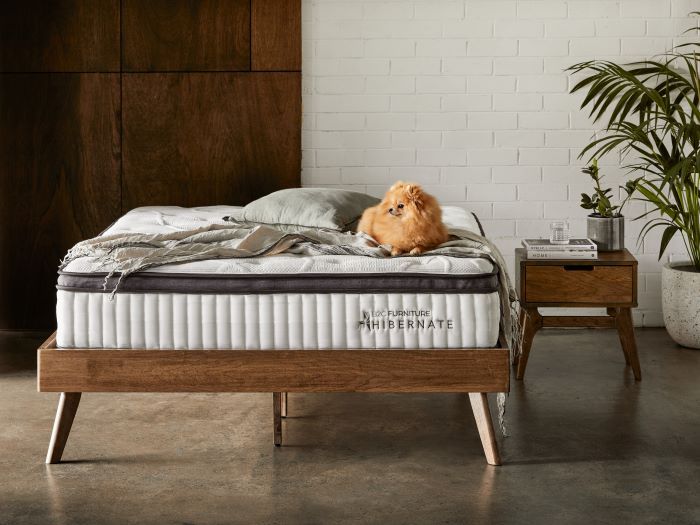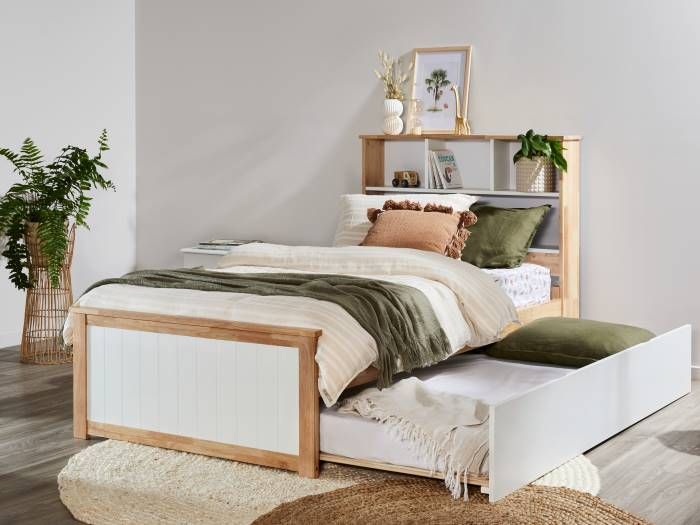A good mattress is crucial for both physical health and sleep quality. When considering a mattress upgrade and how to choose a mattress, a good quality mattress is not just about comfort—it’s about supporting your overall health and ensuring you get the restorative sleep you need each night.
In this guide we’ll go through a few different points on how to pick the right mattress for you, including how often you should upgrade a mattress and how to notice signs that your mattress needs replacing, as well as purchasing mattresses and picking out what is best for you including all the benefits of different types of mattresses.

Image source: B2C Furniture
How Long Should You Keep a Mattress?
On average, most mattresses should last 7-10 years. The lifespan of a mattress can vary depending on several factors, including the type of mattress, the quality of materials, and how well it's cared for. Here's a general guideline for the average lifespan of different types of mattresses:
Innerspring Mattresses:
- Innerspring mattresses typically last about 7-10 years on average. Higher quality innerspring mattresses may last up to 10-15 years with proper care.
Memory Foam Mattresses:
- Memory foam mattresses generally last between 10-15 years. Higher density memory foam tends to be more durable and may last longer.
Latex Mattresses:
- Latex mattresses are known for their durability and longevity. A good quality latex mattress can last 15 years or more, with some lasting up to 20 years.
Hybrid Mattresses:
- Hybrid mattresses combine materials like memory foam, latex, and innerspring coils. They typically last between 7-10 years, depending on the materials and construction.
There’s also a myriad of factors that contribute to the lifespan of a mattress, including (but not limited to) the quality of the materials being used, the frequency of use, and the proper maintenance and care of your mattress.
Ultimately, while these are average lifespans, individual experiences may vary based on usage and care. It's a good idea to assess the condition of your mattress regularly to determine if it's time for a replacement.
Signs Your Mattress Needs Replacing
Telltale signs that your mattress needs replacing include things like:
- Visible sagging or indentations, as this can affect comfort and support.
- Increased allergies, as older mattresses can accumulate allergens and dust overtime.
- Waking up stiff or sore - a sign the mattress is no longer providing adequate support.
- General discomfort - your mattress should feel comfortable and supportive and if you notice this has changed such as broken sleep patterns or waking up sore due to discomfort - it's time to upgrade!

Image source: B2C Furniture
Should You Flip or Rotate Your Mattress?
Whether you should flip or rotate your mattress depends on the type of mattress you have. Here’s the difference between flipping and rotating, along with recommended guidelines for various types of mattresses:
Difference Between Flipping and Rotating:
Flipping: Flipping a mattress involves turning it over so that the side that was on the bottom is now on the top. This is typically done with double-sided mattresses where both sides are designed for sleeping.
Rotating: Rotating a mattress involves turning it 180 degrees so that the head end becomes the foot end. This is done to promote even wear and extend the lifespan of the mattress.
Guidelines for Different Types of Mattresses:
Innerspring Mattresses
- If your innerspring mattress is double-sided, you should flip it every 3-6 months to even out wear and tear. Even if it's not double-sided, rotating an innerspring mattress every 3-6 months can also help prevent sagging and maintain support.
Memory Foam Mattresses:
- Most memory foam mattresses are designed with specific layers and are not meant to be flipped. Rotate a memory foam mattress 180 degrees every 6 months to ensure even wear, especially if it’s used heavily in one area.
Latex Mattresses:
- Latex mattresses are usually quite durable and resilient. Rotate a latex mattress 180 degrees once or twice a year to prevent body impressions and maintain support.
Hybrid Mattresses:
- Hybrid mattresses combine materials like memory foam, latex, and innerspring coils. Follow the manufacturer's guidelines; some hybrids are designed to be rotated, while others may be double-sided and can be flipped.
How Often to Flip or Rotate
As a general guideline, every 3-6 months is usually the go-to for flipping or rotating mattresses. However, the frequency can vary based on individual use and manufacturer recommendations. If your mattress gets heavier use (e.g., used by two people, or if you have pets that sleep on it), consider rotating or flipping more frequently to maintain support and prevent sagging. We’d recommended schedules for flipping/rotating your mattress to maintain mattress condition.
By following these guidelines, you can extend the lifespan of your mattress and ensure that it continues to provide optimal comfort and support for a longer period.

Image source: B2C Furniture
How to Know When It’s Time to Upgrade Your Mattress
Knowing when it’s time to upgrade your mattress goes beyond visible wear and tear. Here are key signs indicating it’s time for a new mattress, and how your sleep quality and health can be affected by an old mattress:
Sleep Quality and Comfort
Discomfort and Poor Sleep:
- Increased Tossing and Turning: If you find yourself tossing and turning frequently during the night or struggling to find a comfortable position, your mattress may no longer be providing adequate support.
- Waking Up Stiff or Sore: A mattress that no longer supports your body properly can lead to waking up with stiffness, soreness, or even numbness in extremities.
- Lack of Support: Over time, mattresses can lose their ability to support your body's natural alignment, which can lead to discomfort and restless sleep.
- Visible Sagging or Indentations: Check for visible signs of wear like sagging or indentations where you sleep. These depressions indicate that the mattress is no longer able to bounce back and support your body evenly.
- Age of the Mattress: Even if there are no visible signs of wear, consider the age of your mattress. Most mattresses have a lifespan of about 7-10 years, after which they may no longer provide adequate support and comfort.
Health Concerns
Back and Joint Pain: An old mattress that no longer supports your spine properly can contribute to back pain, neck pain, and joint stiffness. Poor spinal alignment during sleep can lead to chronic discomfort and exacerbate existing back problems.
Allergies and Dust Mites: Over time, mattresses can accumulate allergens such as dust mites, mould, and mildew, especially if not properly maintained or if the mattress is old. These allergens can trigger allergies or worsen respiratory issues, affecting your overall health and sleep quality.
Sleep Disorders: A mattress that doesn’t provide adequate comfort and support can contribute to sleep disorders such as insomnia or sleep apnea. Quality sleep is essential for overall health, and a worn-out mattress can disrupt sleep patterns and exacerbate existing sleep disorders.
Upgrading your mattress is an investment in your sleep quality and overall health. As mattresses age, they can lose their ability to provide adequate support and comfort, leading to various discomforts and health issues. Regularly assessing your mattress's condition and paying attention to signs of wear and tear, discomfort, and changes in sleep quality can help you determine when it’s time for an upgrade to ensure you get the restorative sleep your body needs.

Image source: B2C Furniture
Picking Out a New Mattress
Choosing the right mattress is crucial for your sleep quality and overall well-being. Here are some tips to help you pick out a new mattress that suits your needs:
Mattress Types and Their Benefits
Memory Foam Mattresses:
- Pros: Contouring support that conforms to your body shape, excellent for pressure relief, motion isolation (good for couples), and typically durable.
- Cons: Can retain heat, may have initial off-gassing odour, and some people find it lacks bounce.
Innerspring Mattresses:
- Pros: Good support, firmness options, great breathability (keeps cool), and a traditional bounce.
- Cons: Potential for motion transfer, less durable than other types, and may not provide as much pressure relief.
Latex Mattresses:
- Pros: Durable, responsive (bouncy but not too much), excellent for pressure relief, and natural latex can be eco-friendly.
- Cons: Can be expensive, heavier, and may not be as widely available as other types.
Hybrid Mattresses:
- Pros: Combines the benefits of different materials (e.g., memory foam with innerspring coils), good support, pressure relief, and often cooler than pure memory foam.
- Cons: Higher price point, potential for motion transfer depending on design, and can be heavier.
Mattress Firmness
Soft: Provides more contouring and pressure relief, suitable for side sleepers and lighter individuals.
Medium: Balanced support and comfort, suitable for combination sleepers or couples with different preferences.
Firm: Offers more support and less sinkage, suitable for back or stomach sleepers and heavier individuals.
Choose firmness based on your sleeping position and personal preference for comfort and support.
Mattress Size Guide
Amongst the most frequent questions we get asked by our customers at B2C Furniture is “what is the size of the bed and what are the mattress dimensions that will fit it?”
We completely recognise the importance of these questions! The last thing you want to do is make an exciting new purchase for that bed you have been eyeing off for months, only to realise you don’t have the correct size mattress or vice versa.
We’ve already done all the legwork for you! Check out our previous size guide here where will find a list of the most common bed sizes and the corresponding standard mattress sizes in Australia.
The most important things to consider are the following:
- Comfort: Ensures you have enough space to sleep comfortably, especially if sharing with a partner or pets.
- Support: A properly sized mattress supports your body without causing discomfort or compromising sleep quality.
- Room Space: Fits well in your bedroom without overwhelming the space or causing crowding.
When selecting a mattress, consider your personal preferences, sleeping habits, and any specific health considerations to ensure you find the right balance of comfort and support for restful sleep.

Image source: B2C Furniture
Where to Buy Your New Mattress
When purchasing a new mattress, where you buy it from can significantly impact your shopping experience and satisfaction. Here are factors to consider and the benefits of buying from reputable retailers:
Reputation and Reliability: Choose reputable retailers known for quality products and customer service. Read reviews and testimonials from other customers to gauge their experience.
- Reputable retailers often carry mattresses from trusted brands known for quality materials and construction.
- They offer better customer service, including assistance with mattress selection, delivery tracking, and handling of any issues or concerns.
- They typically have clear policies regarding warranties, returns, and exchanges, ensuring you’re protected in case of defects or dissatisfaction.
Selection and Variety: Look for retailers that offer a wide range of mattress types, brands, and sizes to suit your preferences and needs.
Price and Value: Compare prices across different retailers to ensure you’re getting a competitive deal. Consider value-added services like free delivery, setup, or mattress disposal.
Customer Service: Check for retailers with knowledgeable staff who can provide guidance and answer your questions. Good customer service ensures a smooth shopping experience and post-purchase support.
Convenience: Consider factors like location (if buying in-store), online ordering process, and delivery options to suit your schedule.
Online vs. In-Store
There’s pros and cons of buying a mattress online vs. in-store. Here’s a breakdown from our experience:
Pros of Buying Online:
- Convenience: Shop from home, compare prices easily, and often find better deals.
- Selection: Access to a wide range of brands and models that may not be available locally.
- Reviews: Read customer reviews to inform your decision.
Cons of Buying Online:
- Lack of Testing: You can’t physically test the mattress before buying, so there’s a risk it may not be as comfortable as expected.
- Return Process: Returning a mattress bought online can be more cumbersome due to shipping logistics.
Pros of Buying In-Store:
- Testing Comfort: You can try out different mattresses to find the one that feels best for you.
- Immediate Delivery: Some stores offer same-day delivery and setup.
- Personal Assistance: Sales staff can provide guidance based on your preferences and needs.
Cons of Buying In-Store:
- Limited Selection: Stores may have fewer options compared to online retailers.
- Higher Prices: In-store prices may be higher due to overhead costs.
Warranties and Return Policies
Understanding warranties and return policies is crucial when buying a mattress:
Warranties: Check the length of the warranty, what it covers (e.g., defects, sagging), and any conditions or exclusions.
Return Policies: Understand how long you have to return or exchange the mattress if you’re not satisfied, any restocking fees, and the process for initiating a return.
Upgrading Your Mattress with B2C Furniture
Whether you choose to buy your mattress online or in-store, selecting a reputable retailer ensures you receive quality products, reliable customer service, and clear policies that protect your purchase. Consider your personal preferences, budget, and convenience when deciding where to make your purchase, and always read and understand warranties and return policies to make an informed decision.
B2C Furniture has a great selection of mattresses to choose from, and with physical showroom locations, as well as an online store, we’re here to help with all your mattress needs!





